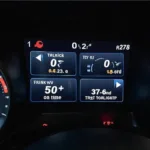An OBD2 interface is the bridge between your vehicle’s computer and your diagnostic tools. It allows you to access a wealth of information about your car’s performance, identify potential problems, and even clear trouble codes. This article will delve into the world of OBD2 interfaces, exploring their functionality, different types, and how they empower you to take control of your vehicle’s health.
Choosing the right OBD2 interface can be daunting with so many options available. This guide will provide you with the knowledge you need to make an informed decision, whether you’re a professional mechanic or a DIY enthusiast. After reading this, you’ll be able to confidently navigate the world of OBD2 diagnostics. Want to learn about setting up an ELM327 scanner? Check out our guide on elm327 interface obd2 scanner setup.
What is an OBD2 Interface?
An OBD2 interface, also known as an OBD2 adapter or dongle, is a hardware device that connects to your vehicle’s OBD2 port, typically located under the dashboard on the driver’s side. This port provides access to the vehicle’s onboard diagnostic system, allowing you to retrieve diagnostic trouble codes (DTCs), monitor real-time sensor data, and perform various other diagnostic functions.
Types of OBD2 Interfaces
OBD2 interfaces come in various forms, each with its own advantages and disadvantages. The most common types include:
-
Bluetooth OBD2 Interfaces: These interfaces communicate wirelessly with your smartphone, tablet, or laptop via Bluetooth. They are generally affordable and convenient for casual users.
-
Wi-Fi OBD2 Interfaces: Similar to Bluetooth interfaces, Wi-Fi adapters offer wireless connectivity but often provide faster data transfer rates. They are suitable for more demanding diagnostic tasks.
-
USB OBD2 Interfaces: These interfaces connect directly to your computer via a USB cable, providing a stable and reliable connection. They are often preferred by professional mechanics.
-
KKL OBD2 Interfaces: These interfaces typically use the KKL protocol for communication. They offer a basic and affordable option for reading and clearing DTCs. Want more info on KKL software? Check out our kkl diagnose interface obd2 software.
Choosing the Right OBD2 Interface
Selecting the appropriate OBD2 interface depends on your specific needs and budget. Consider the following factors:
-
Compatibility: Ensure the interface is compatible with your vehicle’s make, model, and year, as well as your diagnostic software or app.
-
Functionality: Determine the features you require, such as reading and clearing DTCs, viewing live data, performing bi-directional controls, and logging data.
-
Connectivity: Choose between Bluetooth, Wi-Fi, or USB based on your preference and device compatibility. Need an interface for your Android device? See our guide on interface obd2 bluetooth android.
-
Budget: OBD2 interfaces range in price from budget-friendly options to more advanced professional-grade tools.
How to Use an OBD2 Interface
Using an OBD2 interface is generally straightforward. First, locate your vehicle’s OBD2 port and connect the interface. Then, pair the interface with your diagnostic software or app. Once connected, you can access various diagnostic functions. Looking for a PC interface? We have a guide on interface obd2 para pc.
 Connecting and Using an OBD2 Interface
Connecting and Using an OBD2 Interface
Benefits of Using an OBD2 Interface
Utilizing an OBD2 interface offers several advantages, including:
-
Early Problem Detection: Identify potential issues before they become major problems, saving you time and money on repairs.
-
Improved Fuel Efficiency: Monitor fuel consumption and identify factors affecting fuel economy.
-
Enhanced Vehicle Performance: Access performance data and optimize your vehicle’s settings.
-
Increased Control: Gain a deeper understanding of your vehicle’s systems and take control of its maintenance. Need help with your Bluetooth interface passkey? Check our guide on bluetooth diagnostic interface obd2 passkey.
“An OBD2 interface is an essential tool for any car owner. It empowers you to understand your vehicle’s health and make informed decisions about its maintenance,” says Michael Stevens, Certified Automotive Technician.
Conclusion
The OBD2 interface is a powerful tool that opens up a world of possibilities for vehicle diagnostics. Whether you’re a professional mechanic or a car enthusiast, understanding and utilizing an OBD2 interface can help you maintain your vehicle’s health, improve its performance, and save money on repairs. By choosing the right interface and learning how to use it effectively, you can take control of your vehicle’s diagnostics and ensure a smooth and efficient driving experience.
FAQ
- What does OBD2 stand for? On-Board Diagnostics, Second Generation.
- Where is the OBD2 port located? Typically under the dashboard on the driver’s side.
- Can I use any OBD2 interface with my car? No, ensure compatibility with your car’s make, model, and year.
- What can I do with an OBD2 interface? Read and clear trouble codes, monitor live data, and more.
- Do I need special software to use an OBD2 interface? Yes, you’ll need compatible diagnostic software or an app.
- Are OBD2 interfaces expensive? Prices vary depending on features and connectivity.
- Is it difficult to use an OBD2 interface? No, most interfaces are user-friendly.
Need assistance? Contact us via WhatsApp: +1(641)206-8880, Email: [email protected]. We have a 24/7 customer support team.

